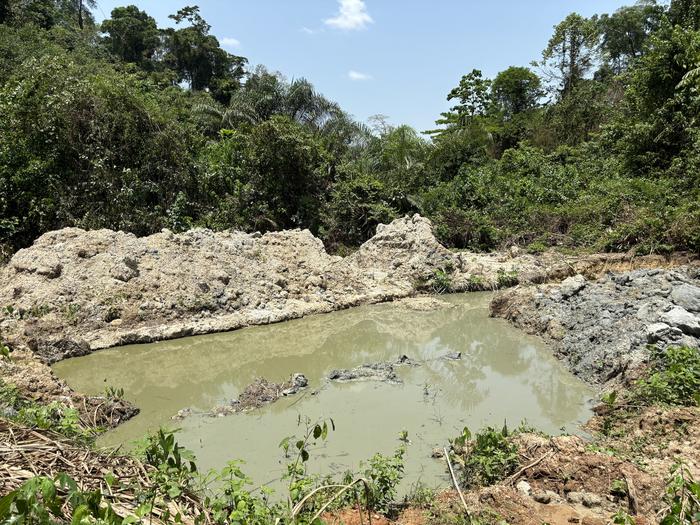New research has found that 4,642 species of vertebrate are threatened by mineral extraction around the world through mining and quarrying, and drilling for oil and gas.

Credit: David Edwards
New research has found that 4,642 species of vertebrate are threatened by mineral extraction around the world through mining and quarrying, and drilling for oil and gas.
Mining activity coincides with the world’s most valuable biodiversity hotspots, which contain a hyper-diversity of species and unique habitats found nowhere else on Earth.
The biggest risk to species comes from mining for materials fundamental to our transition to clean energy, such as lithium and cobalt – both essential components of solar panels, wind turbines and electric cars.
Quarrying for limestone, which is required in huge amounts for cement as a construction material, is also putting many species at risk.
The threat to nature is not limited to the physical locations of the mines – species living at great distances away can also be impacted, for example by polluted watercourses, or deforestation for new access roads and infrastructure.
The researchers say governments and the mining industry should focus on reducing the pollution driven by mining as an ‘easy win’ to reduce the biodiversity loss associated with mineral extraction.
This is the most complete global assessment of the threat to biodiversity from mineral extraction ever undertaken. The results are published today in the journal Current Biology.
“We simply won’t be able to deliver the clean energy we need to reduce our climate impact without mining for the materials we need, and that creates a problem because we’re mining in locations that often have very high levels of biodiversity,” said Professor David Edwards in the University of Cambridge’s Department of Plant Sciences and Conservation Research Institute, senior author of the report.
He added: “So many species, particularly fish, are being put at risk through the pollution caused by mining. It would be an easy win to work on reducing this freshwater pollution so we can still get the products we need for the clean energy transition, but in a way that isn’t causing so much biodiversity loss.”
Across all vertebrate species, fish are at particularly high risk from mining (2,053 species), followed by reptiles, amphibians, birds and mammals. The level of threat seems to be linked to where a particular species lives and its lifestyle: species using freshwater habitats, and species with small ranges are particularly at risk.
“The need for limestone as a core component of construction activity also poses a real risk to wildlife. Lots of species are very restricted in where they live because they’re specialised to live on limestone. A cement mine can literally take out an entire hillside – and with it these species’ homes,” said Ieuan Lamb in the University of Sheffield’s School of Biosciences, first author of the report.
The Bent-Toed Gecko, for example, is threatened by limestone quarrying in Malaysia – it only exists on a single mountain range that planned mining activity will completely destroy.
To get their results, the researchers used International Union for the Conservation of Nature (IUCN) data to see which vertebrate species are threatened by mining. By mapping the locations of these species they could investigate the types of mining that are putting species at risk, and see where the risks are particularly high.
The researchers discovered that species categorised as ‘vulnerable, endangered, or critically endangered’ are more threatened by mineral extraction than species of lesser concern.
Watercourses can be affected in many ways, and water pollution can affect hundreds of thousands of square kilometres of rivers and flood plains. Mining sand as a construction material, for example, alters patterns of water flow in rivers and wetlands, making birds like the Indian Skimmer more accessible to predators.
Mineral extraction threatens vertebrate species populations across the tropics, with hotspots in the Andes, coastal West and Central Africa, and South-East Asia – which coincide with high mine density. For example, artisanal small-scale alluvial gold mining in Ghana threatens important bird areas through environmental mercury pollution.
Global demand for metal minerals, fossil fuels and construction materials is growing dramatically, and the extraction industry is expanding rapidly to meet this demand. In 2022 the revenue of the industry as a whole was estimated at US $943 billion.
Biodiversity underpins the protection of the world’s carbon stocks, which help to mitigate climate change.
The study focused only on vertebrate species, but the researchers say mining is also likely to be a substantial risk to plants and invertebrates.
“There’s no question that we are going to continue to mine – our entire societies are based on mined products. But there are environmental tensions embodied in our use of these products. Our report is a vital first step in avoiding biodiversity loss amidst the predicted drastic expansion of the mining industry,” said Edwards.
“Wildlife is more sensitive to mining in some regions of the world than in others, and our report can inform choices of where to prioritise getting our minerals to cause the least damage to biodiversity. Future policy should also focus on creating more circular economies – increasing recycling and reuse of materials, rather than just extracting more,” said Lamb.
Journal
Current Biology
DOI
10.1016/j.cub.2024.06.077
Article Title
Global threats of extractive industries on vertebrate biodiversity
Article Publication Date
26-Jul-2024




